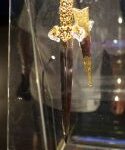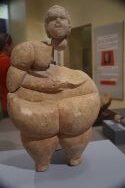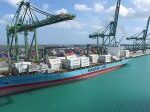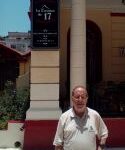“Remember the Maine” was a slogan coined by the “yellow journalists” of the 1890s to encourage American intervention in the (second) Cuban war for independence from Spain. During that struggle, the United States government sent the battleship U.S.S. Maine to monitor conditions here. In February 1898, a mysterious explosion (probably caused by coal dust in the bunkers) sent the ship to the bottom of Havana harbor. The resulting furor led to the Spanish-American war, and the addition of the Philippines as a colony, and Cuba as a protectorate to the American empire.
While my “remembrance” started last night, the full exploration (insofar as four hours can be “full”) had to await the final half day of classes for the Faculty Development trip. It was another morning well spent.
The first speaker, a Canadian-born lawyer, who admitted being a left liberal (possible in Canada; one of our guides at Bissett was a self-proclaimed socialist), talked about his business, as part of a major (1500 partner ) law firm, advising business who want to enter the Cuban market. He literally regaled us with examples, good and bad, of companies that had tried to enter the market without fully understanding the Cubans. One Canadian company, he told us, had done its homework and concluded its business was absolutely essential to Cuba, and believed it would have no trouble negotiating favorable terms. It hadn’t realized that the Cubans do their homework, too, have a strong sense of purpose and plans, and wound up getting Cuban, not Canadian terms. He noted that the Cuban government can sometimes accept ideas if you present them politely and persevere and were patient, citing the example of a Canadian company that had an idea; Canada practices socialized medicine, with free care, but up to an 18 months wait for some surgeries. The company proposed bringing patients with their doctors to use underutilized Cuban hospital space— and to everyone’s surprise, the Canadian company had its plan approved. He admitted that doing business in Cuba is difficult, but can be fair; the large population (relatively), location, and lack of corruption are uncommon in this area; as he noted, “Money doesn’t talk.” He said Cuba has not nationalized without compensation; the sticking point for American companies is that Cuba offered to pay based on the company’s own previous tax valuation, and the State Department has urged those companies to hold out for full repayment.
In thinking about what he said–the preparation, persistence, politeness, and perseverance (you don’t talk business before the third meeting, and don’t presume you know what Cubans need), may well be a clue for doing business with anyone other than Americans, who he said, tend to be too aggressive in international business.
As a Canadian, he has some advantages, having lived here for 25 years; Canadians also constitute over a quarter of the tourists to Cuba–over 1 million. Part of that comes from Canadians escaping winter (when I was in Quebec City with my family one spring break, the snow-covered town was empty; I thought they were all in Florida!). Part may have been, as well, US citizens who could fly to Havana from Montreal. Her presentation, however, gave us a nice look at state planning–with party goals to develop 8 tourist areas, many of them surf and sand resorts along the coastline of Cuba. Some of that has come with foreign expertise, such as we heard about when we spoke to the Melia (Spanish) hotel managers, but I think Sheraton has also signed a memorandum of understanding to run some to-be-built government hotels. She also described the rampant, or perhaps explosive, growth of bnb, one of whose consequences has been to exacerbate an already stretched housing problem. Surprisingly, there are are no regulations for consumer protection, which for me sort of questions the centralized nature of planning.
The final speaker, whom we’ve had several chances to meet, is a young woman, a US citizen married to a Cuban, who teaches English and pursues research in cultural anthropology. Her topic: the consequences of social and economic and political change. I couldn’t help thinking of my trips to Russia and to Eastern Europe, where we repeatedly heard from locals that they “missed” the subsidized life of the Communist regime; “and now,” sighed our guide in Russia, “I am reduced to having to guide to make a living.”
Some of the same things are occurring here in Cuba as a result of Cuban economic directives (the inside factor) and the increasing normalization (external) that have reduced subsidies and increased some market forces particularly through (what seems to me relatively unplanned) development of a private sector. The creation of the directives and a five year plan based on them (by the party) were the result of many “town hall” meetings, where notes were taken, apparently for the first time, anonymously. She said over 8 million participated (population 11 million), and the result slowed either the implementation or changed the direction of the proposals. For example, the company lunch was replaced with a lunch stipend. Many consumer goods used to be distributed through the company (“We have 5 tvs to distribute; you decide which workers deserve them”), whereas now they are distributed on the market, though there are shortages, and some savvy buyers get things by standing in line and resell them. One of the items Cuban-Americans bring back to their families here is a Best Buy TV set, which costs $800 in Cuba, $300 in the US, which can be sold on the black market at $700, making a $400 profit to the family. She said many of the changes need to be “sold” to a society still based on nationalism and socialism, the pillars of the revolution. As I told her at dinner (she shared the rise of helicopter parents among her students, one of whose moms is a Minister, who tried to use her party position to “encourage” the teacher to give the student good grades), what has probably surprised me most about Cuba is the strong influence the revolutionary ideology has–almost 60 years later, and without the purges of Stalin or the lunacy of the Cultural Revolution.
“Class” ended, and I was free to pick up where I’d left off last night. Wearing my “Maine High Adventure” polo, I set out to continue to “remember the Maine.” Last night, that consisted of having my picture taken at the monument to the battleship, which features cannons salvaged from the ship. I was approached by a gentleman who offered to sell me Montecristo cigars for a very reasonable price. He suggested I come to his place. I’d seen that movie, however, and told him I’d meet him at the Nacional, since I had to get cash. He said he was banned from the hotel. We agreed to meet out in front of the hotel. When he arrived, he suggested going into a doorway. I’d seen that movie too, so we exchanged cash for the box of cigars and were both happy. At least I was.
Today, my homage was in the old city, and particularly around the Plaza of Arms, where the troops used to drill. Many were stationed in a fort (the big one is across the bay), the Royal Fortress, now converted into a naval museum, with scale models of caravels and galleons, and gold and silk treasures recovered from sunken ships. The sly guide took my camera and furtively took pictures forbidden of the treasures, by which she added to her treasure….a business opportunity, I think. What I learned there was that the galleons that gathered in Havana Harbor consisted of the treasures of South America via Cartagena, but the Manila galleons came across Mexico! The tower over the fort has a weather vane that has become the symbol of the city.
T
 he former American embassy (through the fifties) is across the square and is now a library, but the other seat of power was the residence of the governor general, which is now the city museum. I used a guide here; the building houses artifacts from the residence (some really wonderful phaetons), and a portrait gallery of the leaders of Cuban independence movements from the first war of independence (1860s) on. The building also houses the first Cuban flag, designed in New York (sic!). Built in the late 18th century, one of the features is a wooden block street in front of it, installed by a governor to please his wife who complained that horses clopping on the street kept her from napping during the day!
he former American embassy (through the fifties) is across the square and is now a library, but the other seat of power was the residence of the governor general, which is now the city museum. I used a guide here; the building houses artifacts from the residence (some really wonderful phaetons), and a portrait gallery of the leaders of Cuban independence movements from the first war of independence (1860s) on. The building also houses the first Cuban flag, designed in New York (sic!). Built in the late 18th century, one of the features is a wooden block street in front of it, installed by a governor to please his wife who complained that horses clopping on the street kept her from napping during the day!

 From there, I wandered to the Cathedral square, only to discover that the wonderfully baroque facade was all I was going to see since the church was closed. Instead, I contented myself with a colonial art museum, which contained porcelains, chairs, stained glass, and furniture from the colonial period. It came from France (the nicest stuff), Spain, Italy–and the United States.
From there, I wandered to the Cathedral square, only to discover that the wonderfully baroque facade was all I was going to see since the church was closed. Instead, I contented myself with a colonial art museum, which contained porcelains, chairs, stained glass, and furniture from the colonial period. It came from France (the nicest stuff), Spain, Italy–and the United States.
While I thought about resuming my musical career in Cuba, I think that will have to await my next trip. I’ll not only remember the Maine, but the 15 other faculty I spent the past week with in Cuba.
 Romans to pay soldiers in salt (“salary” comes from it). Today it’s a vacation spot, with some interesting agriculture, the purpose of our visit. I was really envious when we stopped at an overlook and I was close to scuba diving—900 feet below me, in pristine waters, I could see the flags of the divers.
Romans to pay soldiers in salt (“salary” comes from it). Today it’s a vacation spot, with some interesting agriculture, the purpose of our visit. I was really envious when we stopped at an overlook and I was close to scuba diving—900 feet below me, in pristine waters, I could see the flags of the divers. The purpose of our visit, though, was to learn about capers, by going to a caper farm. Something like a million tons of the product come from the Aeolian Islands, so it’s something of a local treat. Capers, we learned, come in four varieties, depending partly on size (small, medium, and large), and on maturity; the previous ones are buds, but you can also eat the fruit. What surprised me was the production process. Those fresh from the plant are inedible, but must be put in salt water for at least 40 days, but the farmer said the best ones are soaked for at
The purpose of our visit, though, was to learn about capers, by going to a caper farm. Something like a million tons of the product come from the Aeolian Islands, so it’s something of a local treat. Capers, we learned, come in four varieties, depending partly on size (small, medium, and large), and on maturity; the previous ones are buds, but you can also eat the fruit. What surprised me was the production process. Those fresh from the plant are inedible, but must be put in salt water for at least 40 days, but the farmer said the best ones are soaked for at  least a year. They’re hand-picked in many small farms by the women, soaked, and then sorted (by a machine that has holes to separate small, medium, and large). There’s also a mechanized bottling set up. We sampled a variety, and were offered the chance to buy capers for different uses, including pesto, which I’m eager to try.
least a year. They’re hand-picked in many small farms by the women, soaked, and then sorted (by a machine that has holes to separate small, medium, and large). There’s also a mechanized bottling set up. We sampled a variety, and were offered the chance to buy capers for different uses, including pesto, which I’m eager to try.











































